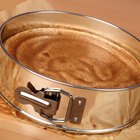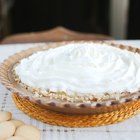
Lemon pie seems like a straightforward, simple dessert, but ignoring the small details can derail your success -- resulting in a soggy, watery mess. Making lemon pie involves three steps -- blind baking the crust, making the lemon filling and adding the meringue topping. Complete each step separately and carefully for a lemon pie that's sweet and smooth, never watery.
The Upper Crust
To avoid a watery lemon pie, start with a crisp crust. Prepare a single piecrust in a pie pan and chill it slightly. Press a sheet of parchment paper or aluminum foil gently into the piecrust and pour some dry beans or rice over the parchment paper, spreading them evenly. The dry beans act as a weight, keeping the crust from puffing up as it cooks. Bake the piecrust until it's golden brown. Remove the beans and bake an additional five minutes or so. Here's the important part: allow the crust to cool completely on a cooling rack before you add the filling. Pouring filling into a hot crust can make it soggy, which can lead to a weepy pie.
Simmer and Stir
Most lemon pie fillings are made from a lemon custard thickened with egg yolks, cornstarch and perhaps butter. Cornstarch is an excellent thickener in most regards. It's inexpensive, widely available and simple to use. However, if you don't cook the custard long enough, the amylase enzyme in the egg yolks will cause the custard to break down as it cools, becoming thin and watery. To prevent this problem, cook the lemon filling for at least one to two minutes after bubbles form on the surface, stirring constantly.
Bake Low and Slow
Meringue toppings are notoriously temperamental and often become weepy when spread on a lemon pie. The reason this happens is that the meringue isn't cooked all the way through. To keep the meringue firm, spread it over the lemon filling, completely covering every bit of the pie. Bake the pie at 350 degrees Fahrenheit for 15 minutes. This slow cooking ensures a solid meringue topping and eliminates the risk of foodborne illness caused by eating raw eggs.
No Leftovers
Even when you do everything right, lemon pie just doesn't store well. Both the meringue topping and the lemon custard are perishable, so you must refrigerate any leftovers. During refrigeration, the moisture in the pie condenses, causing the pie to become soggy. Eat lemon pie the same day you make it for the best results.
Related Articles

How to Prepare Peaches to Make Peach Pie

How to Boil Blackberries & Sugar for a ...
How to Keep Meringue Pie Topping From ...

How to Make Natural Pectin From Lemons
A Substitute for Meringue

How to Make No Bake Strawberry Pie

How to Thicken a Lemon Filling in Baking

How to Make Strawberry Lemonade

Rolled Oats vs. Quick Oats for Apple ...

Sugar-Free Coconut Cream Pie

How to Make New York Cheesecake

How to Cook Strawberries

How to Make Easy Pudding Pie

Can I Use Raspberry Jelly as Cake ...

How to Bake an Apple Pie in a ...
Can I Use Flour Instead of Cornstarch ...

How to Make a White Decorator Icing

How to Store Lemons Long-Term

How to Eat Raspberries

Brownie Bottom Butterscotch Cheesecake ...
References
- Fine Cooking: How to Blind Bake a Pie Crust
- Fine Cooking: Custards
- The Art & Soul of Baking; Cindy Mushet
- USDA: Shell Eggs From Farm to Table
Writer Bio
Julie Christensen is a food writer, caterer, and mom-chef. She's the creator of MarmaladeMom.org, dedicated to family fun and delicious food, and released a book titled "More Than Pot Roast: Fast, Fresh Slow Cooker Recipes."
Photo Credits
Jupiterimages/Stockbyte/Getty Images